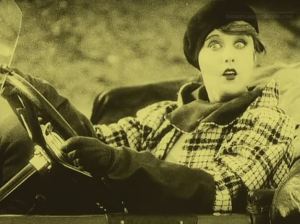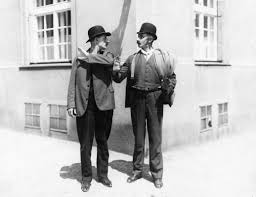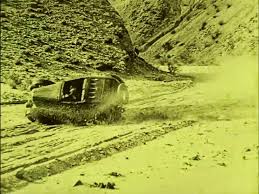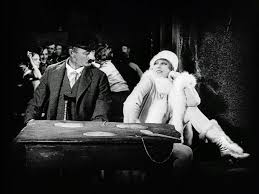Kennington Bioscope at the Cinema Museum
6 February 2019
(Warning: Contains spoilers throughout)
 We were in for a Czech themed evening tonight at the Cinema Museum as the Kennington Bioscope brought us Czech comedy in the shape of An Old Gangster’s Molls (aka The Lovers of an Old Criminal, aka Milenky Starého Kriminálníka) (1927). Introducing the film, Glenn Mitchell and Michelle Facey provided a wealth of knowledge on the film’s director, Svatopluk Innemann, its male comedy lead, Vlasta Burian and the glamourous female lead, the wonderful Anny Ondra. But first, there was themed collection of clips and shorts.
We were in for a Czech themed evening tonight at the Cinema Museum as the Kennington Bioscope brought us Czech comedy in the shape of An Old Gangster’s Molls (aka The Lovers of an Old Criminal, aka Milenky Starého Kriminálníka) (1927). Introducing the film, Glenn Mitchell and Michelle Facey provided a wealth of knowledge on the film’s director, Svatopluk Innemann, its male comedy lead, Vlasta Burian and the glamourous female lead, the wonderful Anny Ondra. But first, there was themed collection of clips and shorts.
First up were clips of Anny Ondra in her two Hitchcock directed silents, The Manxman (1929) and Blackmail (1929), just to give us a taster of her acting skills in a serious role. Then came a couple of Felix the Cat cartoons, or at least (probably) unlicensed Czech versions of the same,  which as well as being quite respectable imitations of the real thing, actually turned out to be public information films, advising their Czech
which as well as being quite respectable imitations of the real thing, actually turned out to be public information films, advising their Czech  audience to ‘work and save’ via their local savings bank. Even more impressive were three cleverly animated cartoons, intended as advertisements for soap powder, toothpaste and (I think) cigarettes, although my Czech language skills (or lack thereof) let me down a bit on that last one.
audience to ‘work and save’ via their local savings bank. Even more impressive were three cleverly animated cartoons, intended as advertisements for soap powder, toothpaste and (I think) cigarettes, although my Czech language skills (or lack thereof) let me down a bit on that last one.
Lastly in this opening sequence was a short film, The Robber (1927). In it, a couple are strolling through the woods and the man is just about to give his girlfriend a slip of paper to mark their third anniversary together when an armed robber accosts them. Not content with the man’s offer of his watch and wallet, the robber tells him to take off his jacket, then his shirt and his trousers. The girlfriend is then told to take off her coat and dress. The thief is just about to depart with his ill-gotten gains when he espies the slip of paper in the man’s hand and demands that also. The man begs the thief to take everything but just leave the piece of paper. When asked what it is, the man replies that it is their ticket to a screening of the film An Old Gangster’s Molls, for which he queued for three hours, which is hugely popular and which is now sold out. Because ‘The Robber’ was in fact the original cinema trailer for tonight’s main feature and quite the most inventive film trailer I think that I have ever come across.
Providing live piano accompaniment for this mixed bag of clips was John Sweeney
 But clever as the trailer was for An Old Gangster’s Molls it gave just an inkling of how good the picture itself was. The film opens at a lavish costume party where factory owner Pardon (Jan W. Speerger) meets Olga Lesczynská (Vera Hlavatá). The two are immediately attracted to each other and agree to meet later in private. But Olga’s mother Stefanie (Betty Kysilková) is wise to such tricks and spirits her daughter away before she can meet up with Pardon. Still thinking of Olga, Pardon receives a letter from his principal creditor Hrazánková advising him that before Pardon’s father died he had agreed that Pardon should marry Hrazánková’s daughter and, provided that the marriage takes place, all Pardon’s debts will be cancelled.
But clever as the trailer was for An Old Gangster’s Molls it gave just an inkling of how good the picture itself was. The film opens at a lavish costume party where factory owner Pardon (Jan W. Speerger) meets Olga Lesczynská (Vera Hlavatá). The two are immediately attracted to each other and agree to meet later in private. But Olga’s mother Stefanie (Betty Kysilková) is wise to such tricks and spirits her daughter away before she can meet up with Pardon. Still thinking of Olga, Pardon receives a letter from his principal creditor Hrazánková advising him that before Pardon’s father died he had agreed that Pardon should marry Hrazánková’s daughter and, provided that the marriage takes place, all Pardon’s debts will be cancelled.
When Hrazánková explains the arrangement to his somewhat over exuberant daughter Fifi (Anny Ondra) she sets off at great haste to meet Pardon. Still hoping to track down Olga, Pardon arranges for his aged and rather decrepit visiting uncle Cyril Pondelícek (  Vlasta Burian) to take his place in the expectation that once Fifi meets Pondelícek she will be put off the marriage and depart none the wiser. Pondelícek initially refuses, fearful of marriage having spent many years trying to evade a woman he once spurned, however a financial inducement soon changes his mind. As he awaits Fifi’s arrival Pondelícek notices a newspaper story about the escape of a notorious criminal, Alois Kanibal, the Robber, who bears an uncanny resemblance to himself. But after a hair-raising arrival, Fifi is not to be put off from marriage. Every excuse Pondelícek uses appears to make Fifi more attracted to him. Even when he claims to be Kanibal the Robber, she luxuriates in the thought of becoming a gangster’s moll.
Vlasta Burian) to take his place in the expectation that once Fifi meets Pondelícek she will be put off the marriage and depart none the wiser. Pondelícek initially refuses, fearful of marriage having spent many years trying to evade a woman he once spurned, however a financial inducement soon changes his mind. As he awaits Fifi’s arrival Pondelícek notices a newspaper story about the escape of a notorious criminal, Alois Kanibal, the Robber, who bears an uncanny resemblance to himself. But after a hair-raising arrival, Fifi is not to be put off from marriage. Every excuse Pondelícek uses appears to make Fifi more attracted to him. Even when he claims to be Kanibal the Robber, she luxuriates in the thought of becoming a gangster’s moll.
Meanwhile, Pardon has stumbled across Olga and invites her and her mother back to his house. By now, Pondelícek is beginning to come round to the notion of marrying Fifi but he gets a shock when he realises that Olga’s mother Stefanie is the woman he spurned. While Pardon and Olga are trying to find some quiet spot to renew their friendship, Pondelícek is trying to escape Stefanie’s advances by  claiming to be a mass murderer who has killed off a series of old girlfriends. He eventually escapes to the city with Fifi, who is still anticipating life as a gangster’s moll. While she pleads with Pondelícek to take her to a gangster’s lair, the real Kanibal the Robber (also played by Vlasta Burian) mounts a daring jewel
claiming to be a mass murderer who has killed off a series of old girlfriends. He eventually escapes to the city with Fifi, who is still anticipating life as a gangster’s moll. While she pleads with Pondelícek to take her to a gangster’s lair, the real Kanibal the Robber (also played by Vlasta Burian) mounts a daring jewel  raid and the police are soon on the trail. Just as Pondelícek and Fifi are discovering that life in a gangster’s lair might not be all its cracked up to be, the real Kanibal arrives. But so do the police and as both the real and the false Kanibal scramble to escape there is a mad chase which ends up in the police station. Eventually things are sorted with Pardon getting Olga, Pondelícek now happily reunited with Stefanie and Fifi hoping for life as a gangster’s moll with the real Kanibal…except that he refuses her advances, claiming that his life of crime would barely pay for her extravagant lifestyle!
raid and the police are soon on the trail. Just as Pondelícek and Fifi are discovering that life in a gangster’s lair might not be all its cracked up to be, the real Kanibal arrives. But so do the police and as both the real and the false Kanibal scramble to escape there is a mad chase which ends up in the police station. Eventually things are sorted with Pardon getting Olga, Pondelícek now happily reunited with Stefanie and Fifi hoping for life as a gangster’s moll with the real Kanibal…except that he refuses her advances, claiming that his life of crime would barely pay for her extravagant lifestyle!
In talking about The Old Gangster’s Molls, the first question is just where to begin, because the above synopsis provides just the bare bones of the plot and wholly fails to capture the frenetic pace of this wonderfully funny film. This is a film which covers virtually every sub-category of the comedy genre. The early scenes of Fifi, luxuriating amongst her many handmaidens while puffing on a Churchillian sized cigar, have the sophistication of Lubitsch and yet the final hectic chase sequence is pure Keystone. And there is everything in between!
Many of the set-piece scenes have a wonderful inventiveness, particularly as Pondelícek tries to scare off Stefanie with his tales of bumping off his former girlfriends, all portrayed in hilarious flashback shots as he poisons one, throws another off a cliff and, funniest of all, attaches a lightening conductor to yet another’s umbrella during a thunder storm.
 In amongst the comedy, there are also some frenetic (and equally funny) action scenes. As well as the aforementioned Keystone chase sequence, there was also Fifi’s unique approach to driving. Although this bit of footage film may have been speeded up, it wasn’t by much and praise must go to some good stunt work, particularly when ‘she’ rolled the car. (And unfortunately its not a picture where the credit line ‘No chickens were hurt in the making of this film’ could be applied!)
In amongst the comedy, there are also some frenetic (and equally funny) action scenes. As well as the aforementioned Keystone chase sequence, there was also Fifi’s unique approach to driving. Although this bit of footage film may have been speeded up, it wasn’t by much and praise must go to some good stunt work, particularly when ‘she’ rolled the car. (And unfortunately its not a picture where the credit line ‘No chickens were hurt in the making of this film’ could be applied!)
 Amongst the cast, Vlasta Burian stood out as Pondelícek. Unknown in the West, he was apparently already a national treasure in 1920s Czechoslovakia, due mainly to his stage and music hall work. Looking a little like a cross between Ben Turpin and Mr Pastry (Richard Hearne) he had beautiful comic timing and that ability of the greatest comedians to generate a laugh from just the slightest look or gesture. But he was also adept at big knockabout comedy as wonderfully demonstrated by his excessively violent Apache dance with Fifi. Although this was one of only four silent films he made, Burian went on to star in some 35 talkies but charges of collaboration during World War Two meant he spent some time in jail which severely damaged his post war career. Although Burian died in 1962 his case was eventually reviewed and he was finally rehabilitated in 1994. In a 2002 Czech TV
Amongst the cast, Vlasta Burian stood out as Pondelícek. Unknown in the West, he was apparently already a national treasure in 1920s Czechoslovakia, due mainly to his stage and music hall work. Looking a little like a cross between Ben Turpin and Mr Pastry (Richard Hearne) he had beautiful comic timing and that ability of the greatest comedians to generate a laugh from just the slightest look or gesture. But he was also adept at big knockabout comedy as wonderfully demonstrated by his excessively violent Apache dance with Fifi. Although this was one of only four silent films he made, Burian went on to star in some 35 talkies but charges of collaboration during World War Two meant he spent some time in jail which severely damaged his post war career. Although Burian died in 1962 his case was eventually reviewed and he was finally rehabilitated in 1994. In a 2002 Czech TV  poll for ‘Comedian of the Century’, Vlasta Burian came out as the winner.
poll for ‘Comedian of the Century’, Vlasta Burian came out as the winner.
But the eye-popping star of The Old Gangster’s Molls had to be Fifi herself. Played by Anny Ondráková, she would shorten her surname simply to Ondra a year later when her burgeoning career took her to Germany. Wearing outfits that would have raised eyebrows in sixties swinging London let alone Prague of the 1920s Fifi cut a swathe through every scene she was in, in a Czech Colleen Moore/Clara Bow flapper sort of way (and then some!). Clearly she and Burian were having a great time making the film and it shone  through in every scene. Although she made her name in Czech and German comedies, Ondra is now best remembered for her dramatic roles in Hitchcock’s The Manx Man and Blackmail, but here in The Old Gangster’s Molls she displays some superb comic timing . Yet while Blackmail was made in both a silent and a sound version, in the talking version Ondra’s strong Czech accent meant that her voice had to be dubbed by English actress Joan Barry. This effectively ended Ondra’s career in English speaking films and she returned to Germany where she continued making films in close partnership with Czech director Karel Lamac where they established their own production company before eventually going their separate ways. Ondra continued to make films until the mid 1950s, before her
through in every scene. Although she made her name in Czech and German comedies, Ondra is now best remembered for her dramatic roles in Hitchcock’s The Manx Man and Blackmail, but here in The Old Gangster’s Molls she displays some superb comic timing . Yet while Blackmail was made in both a silent and a sound version, in the talking version Ondra’s strong Czech accent meant that her voice had to be dubbed by English actress Joan Barry. This effectively ended Ondra’s career in English speaking films and she returned to Germany where she continued making films in close partnership with Czech director Karel Lamac where they established their own production company before eventually going their separate ways. Ondra continued to make films until the mid 1950s, before her  eventual death in 1987.
eventual death in 1987.
Amongst the rest of the cast, Jan W. Speerger as Pardon and Vera Hlavatá as Olga were quite satisfactory. As for Stefanie, although played by someone called Betty Kysilkova, I still wouldn’t have been surprised if it wasn’t a man in drag. But best of all amongst the supporting cast was the unknown actor playing Pardon’s aged and easily shocked butler, especially in the scene where a scantily clad Fifi instructs him to give her a massage.
Although the film’s director, Svatopluk Innemann, was the son of a theatre director and an opera singer, he first began work as a pork butcher before developing in interest in film, becoming first a cameraman and then directing his first film, a version of Little Red Riding Hood, in 1920. He made the transition to talkies but his career had gradually petered out by the late 1930s. Yet he clearly had an excellent feel for comedy. Also worth a mention was the cinematography by Otto Heller who would go on to a very distinguished international career working on films such as The Ladykillers (1955), Peeping Tom (1960), The Ipcress File (1965) and Alfie (1966).
Lastly, a word about the Inter-title translation on the version screened tonight which was particularly good, especially in the titles delivered as rhyming couplets, although when Kanibal threatens Pondelícek with violence I’m not sure if the phrase “I’ll tear you a new one” was in regular parlance in 1920s Czechoslovakia!
The excellent live piano accompaniment for the film came from John Sweeney and Cyrus Gabrysch, making a seamless transition from one to the other mid-film.
The Old Gangster’s Molls is available on disc from the Czech National Film Archive.
